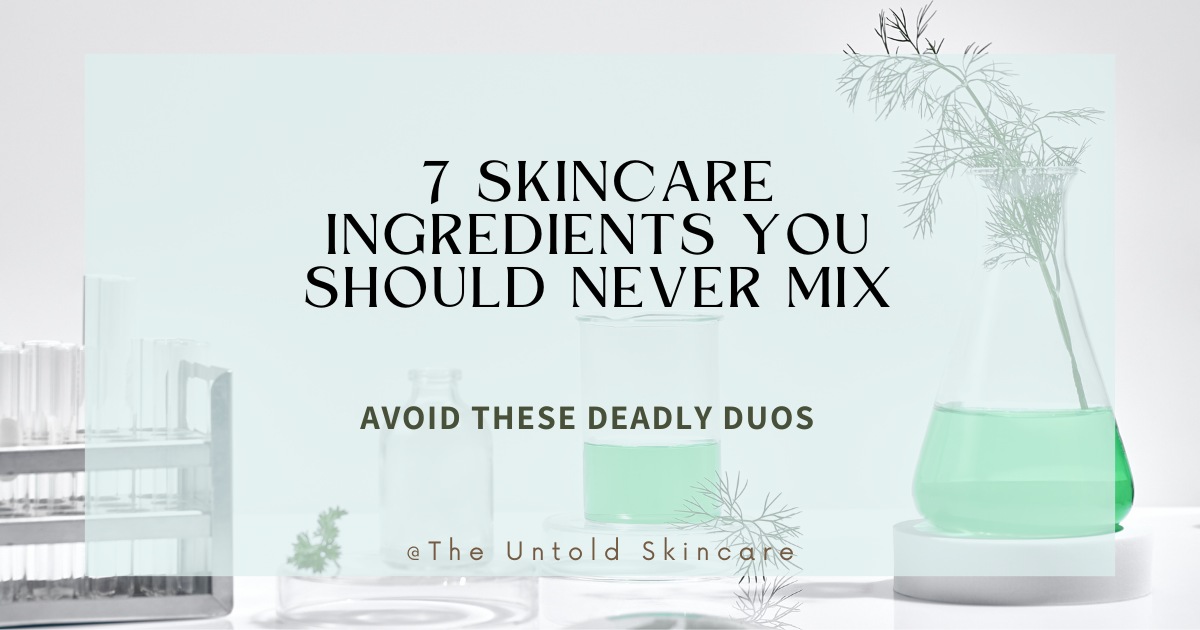When it comes to skincare, it’s easy to get caught up in the excitement of trying out new products and experimenting with different combinations. However, some ingredients simply don’t play well together and can lead to adverse effects on your skin.
With countless skincare products flooding the market, it can be tempting to mix and match products without considering their compatibility. However, this can lead to detrimental effects on your skin’s health and appearance.
Why is it Essential?
Understanding why skincare ingredient combinations matter is essential for maintaining good skin. Different ingredients have unique properties and interactions with each other.
Some combinations can enhance each other’s benefits, while others can cancel out their effectiveness or even damage the skin. So you should know which skincare ingredients should not be mixed.
There are basically two things that determine the incompatibility of skincare ingredients:
- pH levels: Mixing ingredients that have opposite pH levels can disrupt the skin’s natural balance and lead to irritation or dryness.
- Reactivity: Some skincare ingredients can interact negatively and create chemical reactions that damage the skin barrier.
In this article, we will discuss some of the worst skincare ingredient combinations that can cause severe damage to your skin. So, let’s start.
7 Combinations of Skincare Ingredients You Should Never Mix
Retinol and Vitamin C
Both retinol and vitamin C are powerhouse ingredients that offer a multitude of benefits for your skin. Individually, these ingredients can work wonders for your skin. However, when combined, this can be one of the worst skincare ingredient combinations for many people.
Vitamin C is often formulated at a lower pH (more acidic) to be effective, while retinol works best at a slightly higher pH. Mixing these two ingredients together could potentially alter their pH levels, leading to decreased effectiveness and skin irritation.
Using them together may increase the risk of irritation, redness, or even peeling, as the combined effects might be too harsh for some skin types.
Retinol is preferred to use at night since it makes the skin photosensitive. Vitamin C works best during the daytime. So, the simplest of solution is to use Retinol at night and vitamin C at morning.
Retinol and AHA/BHA
Both retinol and AHA/BHA are strong actives. Retinol is a potent ingredient that accelerates cell turnover, and combining it with exfoliants like AHA/BHA can overload the skin, leading to sensitivity and flakiness.
Using both retinol and AHAs/BHAs simultaneously can lead to over-exfoliation, which can weaken the skin’s natural protective barrier and lead to inflammation. Over-exfoliation can make the skin more vulnerable to environmental stressors and bacterial infections.

A key thing is that both retinol and AHA/BHA can cause skin irritation when you first start using them. Mixing them together can further irritate your skin and make it even more sensitive.
Both retinol and AHA/BHA are well known for making the skin more susceptible to sunburn. Using them together can amplify it.
Additionally, AHAs and BHAs work best at lower pH levels, while retinol may require a slightly higher pH to be most effective. Combining them may alter the pH and reduce the effect of one or both. So, you just cannot mix AHA and BHA with Retinol.
Benzoyl Peroxide and Retinol
This is actually a well-researched skincare ingredient combination that needs to be avoided.
The main reason why you should not mix benzoyl peroxide and retinol is that they both degrade the effectiveness of each other. Benzoyl peroxide is an oxidizing agent, which means it can break down the active form of retinol into its less active forms, making it less effective.
If you have just started using these skincare actives, combining these two could be your biggest mistake. Both these ingredients are slightly irritating at first, so using them together can intensify these effects making your skin more sensitive and prone to irritation.
If you wish to include both benzoyl peroxide and retinol as part of your skincare routine, it’s generally advisable to use them on separate occasions, such as benzoyl peroxide in the morning and retinol at night. Also, it’s crucial to introduce these products slowly.
Niacinamide and Vitamin C
Niacinamide and vitamin C are two quite popular skincare ingredients with a lot of potential benefits to the skin. However, some people’s skin can’t really handle their combination.
Some people might not notice any specific problems when using them together, thus this combination is not a flat-out NO for everyone. Combining these two, however, has reportedly led to significant skin rashes and itching in some people.
One of the main concerns is that niacinamide and vitamin C have different pH requirements for optimal effectiveness. Vitamin C is most effective at a low pH (acidic), while niacinamide works best at a neutral to slightly alkaline pH.
Also Read: 6 Worst Ingredients to Avoid in Skincare
Benzoyl Peroxide and Hydroquinone
Mixing benzoyl peroxide and hydroquinone together is definitely a big NO.
Benzoyl peroxide is a strong oxidizing agent, while hydroquinone is a reducing agent. When these two ingredients are applied together, they can react chemically, potentially leading to the formation of dark-colored compounds on the skin.
Both benzoyl peroxide and hydroquinone can be irritating to the skin, especially when used in high concentrations or in sensitive areas. Using them together can increase the risk of skin irritation, including redness, dryness, peeling, burning, or stinging.
So, it is better to use them separately at different times of the day. It is recommended to use Benzoyl Peroxide in the morning and Hydroquinone in the evening.

Retinol and Salicylic Acid
Mixing Retinol and Salicylic acid should be avoided as these skincare actives are known for irritating the skin when used together.
Both of them have different mechanisms of action and can be harsh on the skin when combined. Using them together increases the likelihood of experiencing redness, peeling, burning, and discomfort.
Salicylic acid is a beta hydroxy acid (BHA) and has exfoliating properties. Retinol also has exfoliating effects. Using them in combination can lead to over-exfoliation, which can disrupt the skin barrier and result in increased sensitivity and dryness.
Also, using them together can make your skin more sensitive to external factors such as UV radiation.
You can add salicylic acid to your morning routine and use Retinol in the evening. However, if you have just started using them, I strongly advise you to use them on alternate days.
Glycolic Acid and Salicylic Acid
Glycolic acid and salicylic acid are two extremely potent exfoliants but combining these two may pose risks to your skin.
If you have sensitive or easily irritated skin, combining glycolic and salicylic acid may be too harsh. It can disrupt your skin barrier and lead to inflammation. Combining these acids can lead to over-exfoliation, causing redness, dryness, and skin sensitivity.
The interaction between glycolic acid and salicylic acid is slightly unpredictable. It depends on the product type, its formulation, and the skin type that they are applied on. But in general, the interaction is not quite pleasing to your skin.
A Pro Tip..
If you have acne-prone or sensitive skin, combining any active ingredients may lead to skin discomfort as they are more prone to irritation and adverse reactions. They may react negatively to too many stimuli.
So, my sincere advice for those is to use only one active at a time. You can use different actives on different days if you want to incorporate multiple actives depending on your skin concerns.
Also Read: 5 Best Skincare Ingredients of All Time
Frequently Asked Questions
What not to use with niacinamide?
Niacinamide is a well-tolerated skincare ingredient that can be used alongside many other products. However, there are a few ingredients and products that may not work well when used with niacinamide. Vitamin C, Retinol, Benzoyl Peroxide, and AHA/BHA, are some of the skincare ingredients you shouldn’t use with niacinamide.
What Can’t be Mixed with Vitamin C Serum?
Retinol is the main ingredient that shouldn’t be mixed with vitamin C as it leads to skin irritation and rashes. Additionally, it should not be combined with niacinamide or highly acidic products.
Can I Mix Vitamin C and Niacinamide?
Generally speaking, it depends on your skin type. While some people don’t have any problems using them together, others could have skin rashes and irritation. The best approach to determine whether you can mix them for your skin type is to conduct a patch test before using them.
Can I Use Salicylic Acid with Vitamin C?
Yes, but it is not really recommended to do so.
Both salicylic acid and vitamin C are strong active ingredients. Using them together without proper care can increase the risk of skin irritation, especially if you have sensitive skin.
What Not to Mix with Hyaluronic Acid?
Hyaluronic acid is a popular skincare ingredient known for its ability to hydrate and retain moisture in the skin. While hyaluronic acid is typically safe to use with most skincare ingredients, avoid using it in conjunction with strong acids like glycolic acid, salicylic acid, or retinoids.





